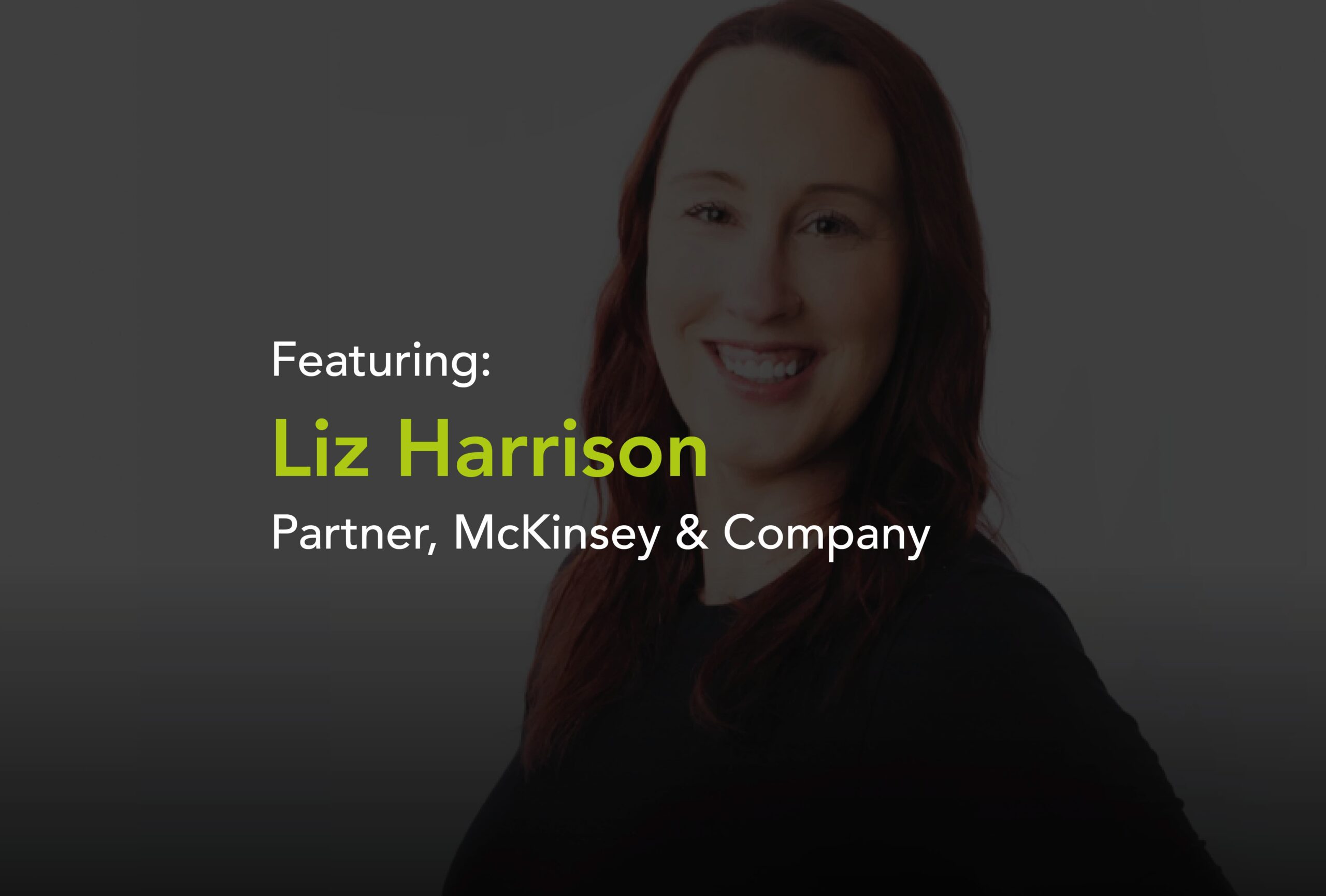
Fireside chat on Growth Marketing
Alisha Lyndon, Founder & CEO, Momentum ITSMA and Liz Harrison, Partner, McKinsey & Company, discuss B2B marketing as a strategic business driver.
Video
Account-Based Growth
Momentum ITSMA Staff
September 25, 2021
Liz Harrison, partner for McKinsey in their marketing and sales practice, joined Momentum ITSMA founder and CEO to discuss how organisations can best enable sales teams for success in the new world of enterprise selling.


As organisations adapt to a new world of digital, remote, and hybrid selling, the topic of sales enablement has taken increasing prominence on the boardroom agenda. Liz Harrison, partner for McKinsey in their marketing and sales practice, joined Momentum ITSMA founder and CEO to discuss how organisations can best enable sales teams for success in the new world of enterprise selling.
Alisha Lyndon: Thanks for joining us, Liz. Before we get started, can you give us more on your background and role?
Liz Harrison: Thanks, Alisha. At the highest level, I work with organisations across industries to help think about growth. Typically, that is focused on how you sell in a time of COVID-19, when your go to market has shifted so radically. New sales roles have been introduced and new ways of selling, and we have seen quite a big change in the role of marketing, especially as we think about B2B interactions.
I also lead McKinsey’s research on B2B decision makers. This is research that we invest in, that we’ve been doing for many years, and I get a chance to really be at the forefront of understanding how customer demands are changing and the implications that has on B2B sales and marketing.
AL: I’m looking forward to unpacking that with you today in this conversation. You touched on it there in your introduction, but we’ve seen so much of the buyer journey shift to digital over the past few years. How have you seen organisations shift their go to market?
LH: I think that the biggest changes have been around the pace of change. Omni-channel selling or selling through both digital and in person is nothing new. What has happened over the past 18 months is the rapid introduction of new sales roles and hybrid sales. There are sales reps that now mostly sell remote and organisations across the board are setting up e-commerce at rates that we’ve never seen before. That means you’re having to manage these different routes to market in a way that they don’t compete with each other. We are actually finding a lot of organisations that we’ve worked with are having to manage channel conflict and figure out what is the role of e-commerce versus hybrid sales versus my traditional routes to market in a way that they never have before.
AL: How do you do that. How can organisations really upskill and build that muscle within sales teams when the channels themselves are so new?
LH: I don’t think anyone has completely nailed it. I think many organisations are still learning the required skill set of the sales rep of a future, as well as the ideal incentive structure.
Most work is around experimentation. For example, there’s more team sales than ever before whereby hybrid sellers need to pull together a team of experts that can all join a video sales call. So, a lot of organisations are experimenting with split compensation, knowing that it’s more of a team sport. There is more investment in capability building than we’ve ever seen before.
It’s a bit of a journey. We know that incentives are a big deal. We know targeted training is a big deal. And a lot of organisations are still figuring out the clarity of what exactly is the mandate of a hybrid seller versus an inside seller versus the key account manager, but I don’t think anyone has figured it out yet.
AL: What advice can you give to our listeners as they think about how to best balance digital interactions and e-commerce versus the individual sellers talking to customers to get that human touch?
LH: It’s a really tricky thing to figure out. I think it all comes down to understanding where in the customer journey digital plays a role. By “digital” here I mean self-service or action that is unguided by a sales rep, and a good rule of thumb is that a third of the time customers want self-service, they want to completely do it on their own; a third of the time they prefer remote interaction; and a third of the time they want in person.
Those percentages will vary by industry, by type of sale, and so on, and it all comes down to if a B2B customer is purchasing something for the very first time or not. More often than not a first-time buyer is going to want to do some of their research self-serve and uninterrupted by the sales team, but as it comes down to really wanting to deeply compare options or when it comes down to negotiating then the in-person touch matters a lot.
Then, as we get later in the journey, when the customer wants to reorder or subscribe, it can be an automatic repurchase where they can return to more of that self-service digital model.
So, it’s a balance along the buyer journey and being very clear, both as an organisation and to your sales team, when each of these different channels need to play up or play down.
AL: And one of the trends that we’ve seen in enterprise buying is that transparency is more critical than it’s ever been. Is that something you’ve encountered in your work too?
LH: My general observation is that transparency is more often than not driven by smaller players introducing comparison sites that provide a lot of brief details around pricing and allow customers to compare and contrast. To some extent, that has forced transparency among some of the larger players.
I actually think hybrid selling, and the ability to share your screen in a remote environment, or the ability for a customer to actually have the information of Google at their fingertips while they’re talking with a remote seller, has increased transparency too. I think it will continue to increase and play a big role in how sellers negotiate, knowing that customers have a lot of comparative information at their fingertips that they may not have in the past.
AL: Do you think that transparency is also about buyer sophistication? It feels like lots of customers and prospects are much more sophisticated when it comes to approaching the buying cycle, or that they’re better informed, or armed with more capabilities in terms of how to navigate their own buying journey.
LH: Yes and no. I think we have seen a general trend of B2B customers becoming more sophisticated and knowledgeable. This has big, big implications on when and how they need a sales rep to be involved in that initial research stage. I mentioned more often than not B2B customers want to do the research on their own, and that’s because they’re empowered to do so. They don’t need to rely on a sales rep to tell them about the range of options.
However, at the same time there is a lot of complexity in what B2B customers can buy. I think organisations realise that for some things that they sell B2B customers are going to be really familiar with the content, but for new software, new technology, they may not be comfortable and may actually be afraid to ask some of the basic questions. There is an opportunity here for the seller to be incredibly valuable in the research stage.
AL: I’d love to talk a little bit more how sales reps can develop unique value propositions for customers. That’s always been a barrier to revenue: if your sellers can’t articulate the value of the firm to a customer then the sale stalls or the opportunity ends up becoming blocked. Have you had any experience in how to equip sellers with those custom value propositions?
“I think arming sellers to be able to communicate not only the unique value proposition of their company or of this specific product or service, but also of themselves, is incredibly critical.
Liz Harrison, Partner at McKinsey
LH: I think arming sellers to be able to communicate not only the unique value proposition of their company or of this specific product or service, but also of themselves, is incredibly critical. There has been a big push in not only being able to articulate the value prop but to quantify it, and to quantify how well they have delivered on the value proposition as a way of engaging with customers throughout the year. I’ve seen some organisations literally say for every product, service, repair, warranty, here’s the value that you will get from doing business with us versus others, let’s check in three months from now to see how well we’re collectively delivering on that value proposition.
AL: What do you think is driving firms to invest more in their sellers? Is it about these new roles that are forming or is it about equipping them to sell in a different world?
LH: It’s all of the above, plus two additional forces.
The role of data and being able to get smarter about your customer and the unique selling situation is critical. Sales enablement teams have a really powerful role to play in enabling sellers with as much data about the customer and situation and value proposition as possible.
The second point is that functions which previously existed in a bit of a siloed fashion are being forced more so than ever before to collaborate together because of hybrid selling, because of these multiple meaningful routes to market. Marketing and sales now have to work incredibly closely together at multiple stages of the journey and sales enablement is the glue making sure that all these cross-team interactions happen, making sure that the sellers have the data and information at their fingertips.
AL: You talked a little bit earlier about how selling is changing and that it’s more of a team sport. How’s that impacting sales enablement? Is sales enablement needed less because you’re bringing all your experts together or is it needed more because you now have experts and subject matter specialists involved in a buying process who may not be sales savvy?
LH: Because you can now sell via video and don’t have to get on a plane and fly across the globe to be part of a sales conversation, you can now have five people on a call – and that could even be my head of R&D or my Chief Commercial Officer. I have absolutely the best experts in that discussion. And because of that dynamic I would say that sales enablement needs to play less of an expert role and more so of a co-ordination role, making sure that all the right people are showing up, making sure that they have the context, making sure that they’re prepared for the conversation, and being that facilitator. My sense is because of hybrid sales and because of team selling there’s less of a need for sales enablement to be the true expert in every topic.
AL: We’ve definitely seen sales enablement focus heavily on content, value proposition development, insight, and training. What do you think the diet of sales enablement will look like as we head forward into the next year?
LH: There will be a huge focus on leveraging all data available about the customer and the situation, and ensuring that marketing and sales are working together and co-ordinated throughout that effort. I think there will be a big focus on ensuring the right type of experts are brought in at different stages of the journey.
I could also see sales enablement playing a big role in owning the end-to-end customer journey – understanding where each customer is on their journey and knowing which set of interactions would be ideal, ensuring the right individuals are used, the right channels are used, the right value proposition is used, etc, along each step in the journey.
AL: I really love that idea, almost a conductor in the orchestra, which right now feels like it’s falling between stalls. Marketing, sales, CX-type roles all claim to own that insight role. Why do you think sales enablement is best placed to do that?
LH: What you just said really struck a chord, because I actually feel there’s been such a focus on understanding the customer, getting customer insights, building this 360 view, and mapping out customer journeys galore, and it’s beautiful, but, then who owns it? Often, it’s actually a tension between the sales team or marketing or customer experience. I would have to agree with you that it is starting to fall through the cracks because there’s a lack of clarity on, number one, who defines it and who approves that that’s the ideal, then who monitors it and makes the execution happen. It’s unclear in a lot of organisations.
AL: I think part of the struggle is selling and marketing into accounts is a bit like a soccer game where marketing and sales have to be passing the ball to each other as they head down the field. And the challenge is that unless that ownership and charter sits with someone, it’s very easy to fall into channel conflict.
LH: There are challenges around ownership, but I think there are also challenges around visibility. If a seller logs into their CRM of choice, they’re not always able to see that a given customer received these specific marketing communications and had outreach from this inside seller. So, if they don’t have that visibility at their fingertips, it makes it increasingly difficult to stay co-ordinated. That means there’s a challenge around decision rights and clarity around who makes what call, but also a lack of information to enable that cross-functional coordination.
AL: You hit a nerve there in terms of access to data and information. How can you ensure things are not lost in the system when you’ve got multiple touchpoints and multiple handoffs?
LH: This is a problem that will increasingly hamper organisations that don’t figure it out because at the same time organisations are struggling with this, we’re finding in our research that B2B customers are demanding personalised marketing outreach more so than ever before. They don’t want a generic email, they want communications tailored to them on multiple facets, not only their role but their industry, the stage where their company is and thinking through an issue.
Couple the increasing demands for personalisation with this inherent complexity around decision-making rights and lack of visibility in B2B organisations that are trying to serve these customers, and I could foresee these two sides coming together in not a not a great way.
AL: I think sometimes with marketing there’s a tendency to say personalising is putting on a company name or a company logo, but actually it’s, as you talked about: knowing their role, where they are as an organisation, where they are as a function and really talking about their specific positions.
LH: Absolutely. And, as you’re seeing, buying is getting more complex in these B2B organisations and buying teams are continuing to grow. If sales can’t talk to every stakeholder, then should marketing be playing a bigger role in live opportunities?
I firmly believe that in order for B2B marketing organisations to be credible, they have to interact with customers. When marketing sits in an ivory tower, so to speak, in corporate and they are so far removed from the customers, they disconnected from reality.
But there’s only so many hours in the day. Most organisations have some sort of segmentation and prioritisation of their customers and the highest priority customers are going to get sales team time. But what happens with that longer tail? I absolutely think there’s a need to interact with a longer tail and that should be the role of an inside sales team or marketing – I’ve seen both work.
But what I would say is I think there needs to be a very deliberate marketing and sales approach by customer segment. That means asking: when does this customer get the key account seller and this type of marketing outreach versus another option?
I think marketing, insight, sales, or any role that somehow touches the customer, has to have the opportunity to interact with the customer, and also deeply understand what customers want. I think, dissemination of insights is a key role for sales enablement going forward.
AL: We hear that a lot from accounts, customers, prospects. They want to hear fresh insights, new sources of innovation, new perspectives from suppliers. Is that something that can be enabled?
LH: I absolutely think it can be enabled and I think sellers demonstrate value when they interact with customers in that way. One of the reasons why we see that some customers don’t want to interact with a sales rep is that it’s faster and more convenient and effective for them not to do so, which means that the seller is not incrementally adding value. It’s just faster for them to google it themselves, for example.
Providing insights to sellers and marketers is absolutely doable, but it requires targeted investment and focus from B2B organisations. I think, by and large, B2B has a huge opportunity to invest more heavily and deliberately in primary research. I think more often than not, customer insights are a side project that happens once a year and that lives on a few PowerPoint pages that get sent to a few folks. Instead, it should be primary research that is updated on a quarterly basis, is disseminated broadly, and is a huge focus of capability building and sales team discussions. I think there’s a long way to go on that on that dissemination and enablement, but it’s absolutely critical.
AL: We’ve seen a huge amount of that. I think focus is the key word there. We’ve seen so many marketing and sales enablement programmes broadly looking at industries or geographies, but actually there’s no colour, there’s no fresh insights. They are almost staying at the macro level and the primary research about the customers themselves is really where all the detail and the nuances come through.
LH: It’s a really important point and I think marketing insights teams also need to connect with the customer directly in order to have credibility. I actually think there’s a really important cross-functional effort to set the research agenda. It should not be just your research team of survey designers or your focus group facilitators, they should not be the ones that are figuring out the key questions and topics. These should be developed jointly with sales, with marketing, with the most senior leadership in the organisation, and executed by the researchers.
The setting of the agenda and the “what does this mean”, I think there’s a real step change in the level of seniority and cross-functional engagement that’s required in those steps. It cannot just live within the research or insights function alone. This has to be an integrated effort.
AL: And what about executives? We’re seeing that US-based enterprise organisations are much more open to switching vendors or suppliers if they have executive engagement from a given vendor or supplier. Have you seen executives want to be enabled, from a selling perspective, or is there some way to go?
LH: Overall, I have seen an increase in the number and variety of different executive roles that want to have some part in the decision-making process. What I mean by that is if there is a software decision to be made, typically that would live with the Chief Technology Officer. But more so than ever before executives ranging from the CMO through to the head of HR and the CEO also want to play a role, get educated on, or interact with potential software because they see that software decision will have implications on their function as well.
That means there’s a need for B2B organisations to involve a wider range of executives in selling too. And this gets back to that contextualising point that you’ve made. How you engage with a CMO is going to be very different than a CTO versus a CFO versus a head of HR, there are going to be different things that matter to them and different and unique value propositions. Similarly, different types of sales reps will connect with them, most likely. I think this then heightens the importance of sales enablement and them playing that co-ordinator role to ensure that the right types of materials get to the right executives, because it’s no longer a single executive who will make the decision on the buying side.
I don’t think we will ever move on from the importance of relationships, especially at the most senior level. I do think we will continue to see the trend of a broader range of executives involved in the decisions, incredible thoughtfulness and how those decisions are made, an increased willingness to compare options. I think all of those things will hold true, but the importance of executive level relationships I don’t think will ever go away.
AL: There’s been a lot of conversation around how much harder selling and marketing is getting. We’ve also heard from customers that it’s actually getting harder for them to buy. Have you seen any examples of where B2B organisations are actually enabling their customers to do the internal selling? Is that a trend that you’re seeing?
LH: I’ve seen some organisations empower an advocate role. So, if the CTO, for example, is a big fan of a certain software that software company could enable that executive to be able to pitch to his or her colleagues on why to go forward with a purchase. They actually enable that CTO to be able to go talk to the CMO with specific value proposition points that will resonate with them.
It’s something that is not done at every B2B organisation, but I think those that are really evolving their model and succeeding are knowing that they need to enable executives to be able to convince their peers that this is a good decision, and provide them with the materials to do so.
AL: If we look at look ahead to the coming few years, what do you think the single biggest change will be in sales enablement? What are we going to see?
LH: I think the single biggest challenge is around talent. It’s becoming increasingly hard to hire and retain top sales and marketing talent. Multiple marketing executives that I am connected with, for example, mentioned it was so challenging them for them to hire the people they needed to stand up their new or larger marketing organisation.
And, because of this challenge of talent acquisition and retention, it’s likely the single biggest change will be a redefinition of what it means to be a seller. I think what it will take to be a B2B marketer in this integrated omni-channel, hybrid sales world will be redefined. And I hope and I expect there to be a pretty radical shift when it comes to talent acquisition and retention, especially when it comes to sales and marketing roles.
AL: And, finally, what’s your single biggest piece of advice for any revenue leader out there in B2B that’s looking to transform their organisation and build the right muscle to help them grow?
ML: Be bold. Now is the time to experiment, to test. The data would bear out that companies that make bolder moves during times of huge change are the ones that have outperformed their peers. So be bold, open up a new channel, experiment with options, figure out how to deliver a truly omni-channel integrated experience to your customers. And don’t expect that the status quo will be what’s needed for success.
Discover more about sales enablement for a hybrid selling world in this Forbes article, written by Momentum ITSMA’s founder and CEO, Alisha Lyndon.
Find inspiration, expertise and creativity to help you grow your most valuable customers by joining our ABM community and receiving the latest news, views and insights from our team of experts at Momentum ITSMA, sign up here.

Alisha Lyndon, Founder & CEO, Momentum ITSMA and Liz Harrison, Partner, McKinsey & Company, discuss B2B marketing as a strategic business driver.
Video

McKinsey's Liz Harrison joins Alisha on the ABM podcast for a Q&A on sales enablement in a world of digital selling
Podcast

Sales enablement has emerged as one of the hottest topics of 2021 and it isn’t hard to see why. That means it is more crucial than ever that your sales teams are equipped with the right tools and information to fully understand their buyers’ industry, challenges and goals.
Article